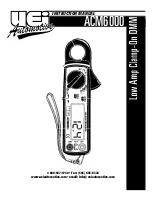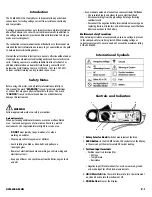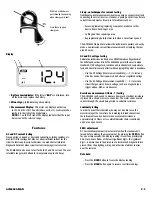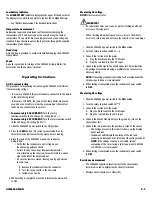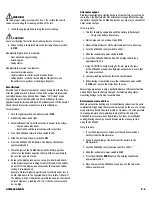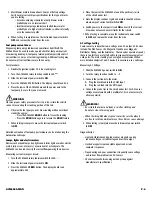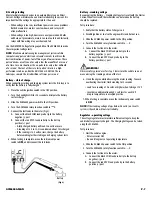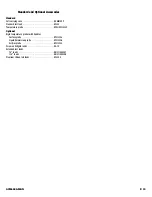
ACM6000-MAN
P. 8
5. System voltage reading should be 13.1 volts to 14.2 volts.
• Check the vehicle service manual for exact specifica t i o n s
7. When testing is complete, move the instrument power
switch to
OFF
and disconnect the test leads.
NOTE:
See the illustration on page 22 for test lead hookup instructions.
TIP:
Low Voltage - Check connections, drive belt, faulty voltage re gu l a t o r.
High Voltage - Usually indicates a faulty voltage re gu l a t o r.
Potentiometer tests
Automotive computer engine management systems depend upon
signals from potentiometer to determine fuel distribution and ignition
timing. If these devices fail or become intermittently faulty, erroneous
data is fed to the computer resulting in poor fuel economy and
driveability complaints. A typical example of a potentiometer is the
Throttle Position Sensor (TPS). To test a throttle position sensor:
Test procedure:
1. Slide the ACM6000 power switch to the
ON
position.
2. Turn the rotary function switch to V.
3. Connect the test leads to the meter.
A. Connect the black COM lead probe tip to the battery
negative (-) post
B. Connect the red VW˚F lead probe tip to the battery
positive (+) post
4. Turn the ignition switch on.
DO NOT
start the engine.
5. Look for a 5 volt reading. (Some vehicles may differ.
Verify the correct reference voltage for the vehicle being tested.)
• If the reference voltage is too high or low, look for a problem with the
wiring harness, connectors or the computer
6. After establishing that the reference voltage is OK, connect the
red lead probe tip to the TPS output wire.
7. Look for low voltage at idle position which should smoothly
increase as throttle is increased. Any erratic voltage readout
indicates a bad sensor. Verify the factory specs for the low voltage
(idle) setting. As little as one tenth of one volt off can make a
difference in vehicle performance. The high voltage (full throttle
voltage) should reach at least 80% of the reference voltage. For
example, it should reach at least 4 volts with a 5 volt reference.
8. Turn the vehicle switch OFF.
9. When testing is complete, move the instrument power switch
to
OFF
and disconnect the meter leads.
Measuring resistance
Resistance measurements are frequently made as a part of automotive
circuit and component testing. Additionally, continuity testing is used to
establish that a circuit is complete (no opens). Continuity testing is a quick
v e r i f i cation that resistance is below a certain level. Levels can vary from
meter to meter. A buzzer sounds when measured resistance is below
approximately 25 Ohms.
Ohms and audible continuity measurements:
1. Slide the ACM6000 power switch to the
ON
position.
2. Turn the rotary function switch to
Ω
.
3. Connect the test leads to the meter.
A. Plug the black lead into the
COM
input
B. Plug the red lead into the V
Ω
˚F input
4. Verify that the circuit under test is completely OFF.
5. Connect the test leads across the lead or circuit to be tested.
6. Read the circuit resistance, displayed in Ohms.
• If the display shows an over-range indication (“1” at the left
side of the display) the circuit resistance is either above the
meter’s 20 0 0
Ω
range, or the circuit is open
NOTE:
The audible continuity feature allows the operator to do quick
resistance tests without looking at the meter display.
• The audible continuity buzzer will sound if resistance is under
approximately 25
Ω
7. When testing is complete, move the instrument power switch
to
OFF
and disconnect the meter leads.
NOTE:
A ny circuit tested that has a voltage applied will not provide an
a c c u rate re a d i n g.
Temperature measurement
A standard accessory with the ACM6000 is a temperature
probe adapter and a K-Type thermocouple. Use the thermocouple probe
tip to contact the component to be measured. Additional probes for air,
fluids, and surface
contact measurements are available.
Air conditioning/heating duct temperature measurement:
1. Insert the thermocouple connector into the adapter.
Observe polarity.
2. Connect the banana plug thermocouple adapter to the ACM6000
black COM and red V
Ω
˚F inputs (Fig. 3). Observe polarity.
3. Turn the rotary function switch to ˚F.
4. Slide the instrument power switch to the ON position.
5. Position the probe tip in the airflow of an A/C-heating duct.
6. Start the engine and set the vehicle temperature controls
for the test. Look for the change in temperature to meet
manufacturers specifications.

